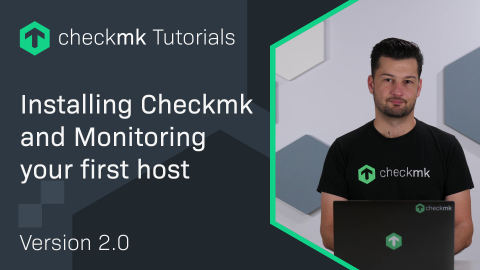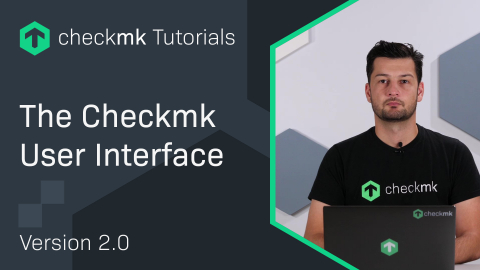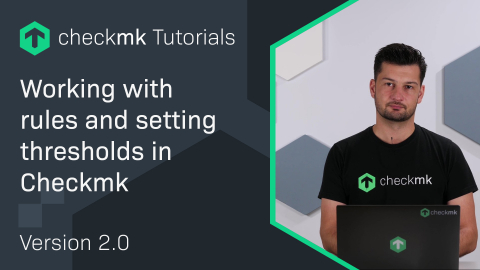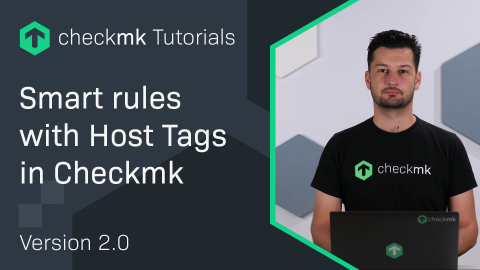Ep. 21: Setting up notifications in Checkmk
| [0:00:00] | Welcome back. My name is Bastian Kuhn and today I'm gonna show you the Checkmk notification system. |
| [0:00:16] | If you want to have email notifications, the only requirement is that your server is able to send out emails. After that, you can configure everything in Checkmk. By default, every contact who is a contact of a service or host gets this notification. |
| [0:00:35] | Therefore, I'm going to show you: how to set contact groups, how to assign these contact groups to services and to users. And later on, you also take a look in the rule based notification system. But now let's have a look. |
| [0:00:51] | At first, I'm going to give you a short overview about the options. Everything is again in the part Setup. With Users, you find the part Contact groups. |
| [0:01:01] | There you can create the contact groups. Then you have the Users part where you assign the users to contact groups. And finally, we need to assign services and hosts and for that we have two options. |
| [0:01:14] | We can either use the rules Assignment of services to contact groups and Assignment of hosts to contact groups or we can also use the folder view if we create a folder. |
| [0:01:30] |
And there you enable show more where you see the permissions. And now I'm going to show how to set up the contact groups. So, we go back to Setup, Contact groups. We already see our default group everything. |
| [0:01:50] | And we just add a second one with name Testing and alias Testing. Now we are ready to assign. At first, I'm gonna assign it to my user therefore I use Setup, Users, pick my cmkadmin. |
| [0:01:30] |
And there you enable show more where you see the permissions. And now I'm going to show how to set up the contact groups. So, we go back to Setup, Contact groups. We already see our default group everything. |
| [0:02:16] | And here I see a part Contact Groups and can check Testing. I need to save it. The problem, now my user has this contact group but none of the services. |
| [0:02:31] | Therefore next part Setup again. I use assign and I want to assign this contact group to every service with the name CPU, for example. |
| [0:02:47] | So, I choose Assignment of services to contact groups. Now we are in the rule-based configuration. |
| [0:02:56] | I create my rule in the main directory, choose my contact group, and as a condition I use every service who starts with CPU. I save this. I activate. And now we can double check if everything works therefore i go to my only host. |
| [0:03:28] | It's a localhost. I have two services with CPU. Click on the first one. And if i scroll down here, as the service contact group is testing and I see service contacts are cmkadmin so that part worked. Now let's take a look into the notification settings, the configuration for the notification system. |
| [0:03:55] | We can also find in Setup and there Events, Notifications. By default, we already have one rule is this one. And this rule does exactly that what we configured before. |
| [0:04:10] | It sends emails to the contacts of the hosts and services which have assigned the same contact group. |
| [0:04:21] | We also see this warning message here. The background about that is that we have a rule-based notification system. That means you can also define rules and it's possible that one notification does not match to any of your rules. |
| [0:04:40] | And for that, you can configure a fallback where the notification should go to then. Then let's look into our default rule. We can edit it here with the pencil. |
| [0:04:55] | Here we can see the rule details, as in other rules we have the Rule Properties. Only the difference here is that you can enable or disable Overriding the rule by users. The next part is the Notification Method. |
| [0:05:13] | Here you can set how you want to get the notification. By default, it's an email or you can choose other options here from the list. |
| [0:05:23] | Also you can install your own options using the extension system. Based on the notification method you use, you have different options to change the notification. It's like you can add or remove information to the notification. |
| [0:05:43] | Next part, a very interesting feature is the Notification Biking. Here you can group together multiple notifications into one notification. |
| [0:05:52] | For example, you can group by host or you can, say, I want to group together everything what is in the same folder and comes inside this range of one minute. |
| [0:06:07] | Only thing you need to know is that if you set, like, five minutes here, you also have to wait five minutes before you get your first notification. |
| [0:06:18] | Next part, the Contact Selection, to where you want to send the notifications. By default, it's the Notify all contacts of the notified host or service. |
| [0:06:27] | This is basically what we configured before with the contact groups. But you can also do your own stuff here and, say like, you want directly notify a special user or you don't even have to have a user, you can do also an email address here. |
| [0:06:50] | If you don't use that switch, I would recommend to set also a condition, otherwise you're going to get everything. And this is why it's called the rule-based notification because you have a lot of possible conditions. |
| [0:07:07] | You can go by folder, host tags, labels. You can go with white- and blacklisting of host names. You can also do the same with services. Basically, build a white or black list with your services and that's it. You just save it afterwards and we are done. |
| [0:07:26] | And the final thing I want to show is the analysis of the Checkmk notification rules. It's a really handy feature. |
| [0:07:36] | You can just click the Show analysis button and you're going to see the last 10 notifications from your system. And now you can just check if the notification would have matched to the rules. |
| [0:07:52] | It's with the first icon. Then you see the green button here, which means this notification would match to this rule. You can even look into the details where you see the context of the notifications. |
| [0:08:07] | This is very helpful if you want to create your own notification plug-in because all these data are in the environment automatically of this plugin. And finally, you can re-trigger the notification with this icon, to really check out if you're gonna receive it. |
| [0:08:25] | I hope this tutorial was helpful for you. If you like, please subscribe and see you next time. |
Interested in learning more? Register for a dedicated Synthetic Monitoring training course.








